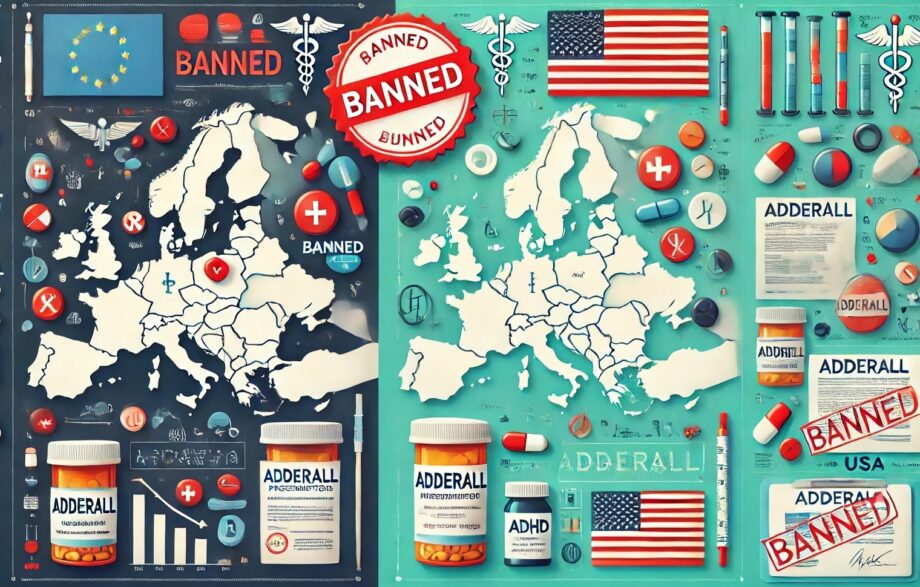Adderall, a widely prescribed medication in the United States for treating Attention Deficit Hyperactivity Disorder (ADHD) and narcolepsy, is banned in most European countries. This discrepancy between the USA and Europe is due to differences in regulatory approaches, public health priorities, and concerns about safety and misuse. Here’s a deep dive into why Adderall is treated differently in these regions.
What is Adderall?
Adderall is a combination of amphetamine salts, primarily dextroamphetamine and levoamphetamine, which act as central nervous system stimulants. It is highly effective in improving focus, attention, and impulse control, especially in individuals with ADHD.
However, Adderall’s stimulant properties make it prone to misuse and dependency, leading to controversy over its safety.
Why Adderall is Approved in the USA
The United States Food and Drug Administration (FDA) has approved Adderall for medical use, primarily due to:
- Effectiveness in Treating ADHD
- Clinical studies demonstrate that Adderall significantly reduces ADHD symptoms in children and adults, improving quality of life.
- It is one of the most prescribed ADHD medications, with millions of prescriptions written annually.
- Strict Regulation and Monitoring
- In the USA, Adderall is classified as a Schedule II controlled substance under the Controlled Substances Act. This means it has recognized medical uses but also a high potential for abuse.
- Patients can only obtain Adderall with a valid prescription, and pharmacies are required to monitor its distribution carefully.
- Cultural and Clinical Acceptance
- The USA has a long history of using stimulant medications for ADHD treatment. This cultural acceptance has normalized its use within strict medical guidelines.
Why Adderall is Banned in Europe
In Europe, most countries do not allow Adderall due to concerns about its safety profile and the availability of alternative treatments. Key reasons include:
- Health and Safety Concerns
- Risk of Addiction: Adderall’s amphetamine content has a high potential for abuse, leading to addiction in some individuals. European regulators have prioritized minimizing exposure to such risks.
- Cardiovascular Side Effects: Adderall is associated with side effects like increased heart rate and blood pressure, which can be dangerous for certain patients.
- Preference for Non-Amphetamine Alternatives
- Europe has approved alternative ADHD medications, such as methylphenidate (Ritalin) and atomoxetine (Strattera), which are considered safer and less addictive.
- The European Medicines Agency (EMA) often emphasizes treatments with a lower abuse potential, aligning with a more cautious public health approach.
- Regulatory Philosophy
- European health agencies tend to adopt a more conservative stance toward approving medications with high abuse potential. This precautionary principle is applied to prioritize long-term public health over individual benefits.
- Amphetamines, including Adderall, are classified as controlled substances in many European countries, effectively banning their use outside of highly restricted circumstances.
- Lack of Manufacturer Support
- In many European countries, Adderall’s manufacturer has not pursued regulatory approval, likely due to stringent requirements and the already established presence of competing medications.
Comparative ADHD Treatment Approaches
- United States:
- The USA has embraced stimulant medications like Adderall as a first-line treatment for ADHD. This reflects the prioritization of rapid symptom relief and the strong influence of pharmaceutical companies.
- Europe:
- Non-stimulant and less addictive medications are often the first choice for treating ADHD. Behavioral therapy and holistic approaches are also emphasized as part of a comprehensive treatment plan.
Potential Consequences of Banning Adderall in Europe
- Limited Access for Patients Who Need It
- Some patients may not respond adequately to alternatives like Ritalin or Strattera, potentially leaving them without effective treatment.
- Off-Label Use and Black Market Risks
- The ban can drive individuals to seek Adderall through unregulated channels, increasing the risk of counterfeit or unsafe products.
Alternatives to Adderall in the UK
For those seeking alternatives when Adderall is banned, several effective options are available, each offering unique benefits. Modafinil is a popular choice for improving focus and alertness, particularly for individuals who need to stay awake and concentrate for extended periods. It is often used off-label as a cognitive enhancer and has a lower risk of addiction compared to traditional stimulants. Another alternative is atomoxetine (Strattera), a non-stimulant medication approved for ADHD treatment. It works by affecting norepinephrine levels in the brain, offering a safer option for those who may experience side effects from stimulant medications. Both of these options provide effective treatment for ADHD and related conditions while minimizing the risks associated with stimulant-based drugs like Adderall.
Conclusion
The differing stances on Adderall in Europe and the USA highlight contrasting approaches to balancing medical benefits and public health risks. While the USA permits Adderall under strict regulation, Europe has opted for caution, banning the drug in favor of alternatives with lower abuse potential.
For individuals with ADHD, these regulatory differences can significantly impact treatment options, often requiring patients to navigate complex healthcare systems to find effective and safe solutions. Regardless of regional differences, the debate underscores the need for ongoing research into ADHD treatments and a nuanced approach to managing their risks and benefits.


